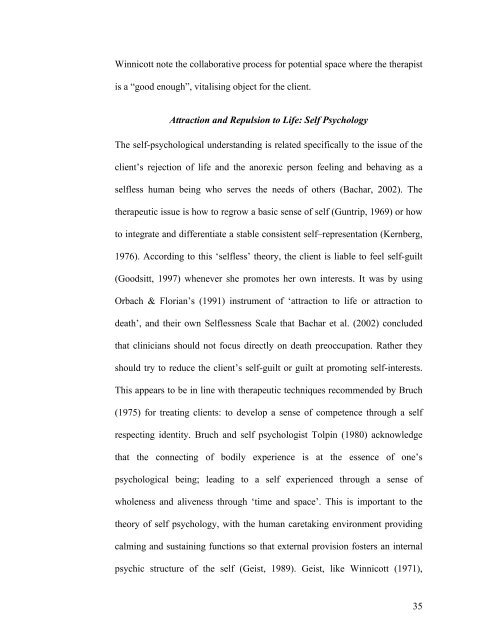“Ghosts at the banquet” - Scholarly Commons Home
“Ghosts at the banquet” - Scholarly Commons Home
“Ghosts at the banquet” - Scholarly Commons Home
You also want an ePaper? Increase the reach of your titles
YUMPU automatically turns print PDFs into web optimized ePapers that Google loves.
Winnicott note <strong>the</strong> collabor<strong>at</strong>ive process for potential space where <strong>the</strong> <strong>the</strong>rapist<br />
is a “good enough”, vitalising object for <strong>the</strong> client.<br />
Attraction and Repulsion to Life: Self Psychology<br />
The self-psychological understanding is rel<strong>at</strong>ed specifically to <strong>the</strong> issue of <strong>the</strong><br />
client’s rejection of life and <strong>the</strong> anorexic person feeling and behaving as a<br />
selfless human being who serves <strong>the</strong> needs of o<strong>the</strong>rs (Bachar, 2002). The<br />
<strong>the</strong>rapeutic issue is how to regrow a basic sense of self (Guntrip, 1969) or how<br />
to integr<strong>at</strong>e and differenti<strong>at</strong>e a stable consistent self–represent<strong>at</strong>ion (Kernberg,<br />
1976). According to this ‘selfless’ <strong>the</strong>ory, <strong>the</strong> client is liable to feel self-guilt<br />
(Goodsitt, 1997) whenever she promotes her own interests. It was by using<br />
Orbach & Florian’s (1991) instrument of ‘<strong>at</strong>traction to life or <strong>at</strong>traction to<br />
de<strong>at</strong>h’, and <strong>the</strong>ir own Selflessness Scale th<strong>at</strong> Bachar et al. (2002) concluded<br />
th<strong>at</strong> clinicians should not focus directly on de<strong>at</strong>h preoccup<strong>at</strong>ion. R<strong>at</strong>her <strong>the</strong>y<br />
should try to reduce <strong>the</strong> client’s self-guilt or guilt <strong>at</strong> promoting self-interests.<br />
This appears to be in line with <strong>the</strong>rapeutic techniques recommended by Bruch<br />
(1975) for tre<strong>at</strong>ing clients: to develop a sense of competence through a self<br />
respecting identity. Bruch and self psychologist Tolpin (1980) acknowledge<br />
th<strong>at</strong> <strong>the</strong> connecting of bodily experience is <strong>at</strong> <strong>the</strong> essence of one’s<br />
psychological being; leading to a self experienced through a sense of<br />
wholeness and aliveness through ‘time and space’. This is important to <strong>the</strong><br />
<strong>the</strong>ory of self psychology, with <strong>the</strong> human caretaking environment providing<br />
calming and sustaining functions so th<strong>at</strong> external provision fosters an internal<br />
psychic structure of <strong>the</strong> self (Geist, 1989). Geist, like Winnicott (1971),<br />
35
















